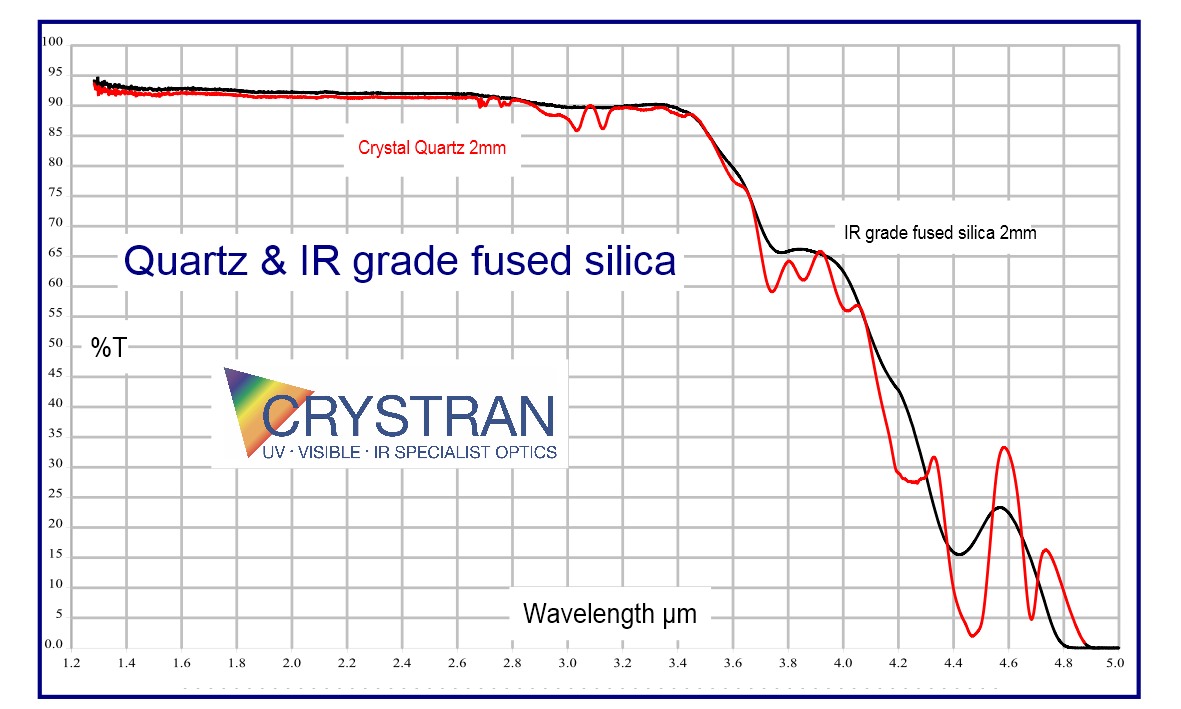

Crystal Quartz SiO2
Optically, Crystalline Quartz is used extensively as a wave retardation medium. The birefringent properties of Quartz are of use in quarter-wave plates and in polarisers. Quartz should not be processed or used at temperatures greater than 490 °C
Crystalline quartz is also used for electronic filters and resonators. However, Crystran Ltd. does not deal in material for this application.




To download this data or our SDS safety data sheet as a pdf, please click on the links at the top of the page. To expand the transmission graphs, please click on the image.
Click to access our Quartz Crystal (SiO2) Guide
Click to access current Crystal Quartz Stock Windows
| µm | No | Ne |
|---|---|---|
| 0.193 | 1.661 | 1.675 |
| 0.213 | 1.632 | 1.645 |
| 0.222 | 1.622 | 1.634 |
| 0.226 | 1.619 | 1.630 |
| 0.248 | 1.602 | 1.613 |
| 0.257 | 1.596 | 1.607 |
| 0.28 | 1.585 | 1.596 |
| 0.308 | 1.576 | 1.586 |
| 0.325 | 1.571 | 1.581 |
| 0.351 | 1.565 | 1.575 |
| µm | No | Ne |
|---|---|---|
| 0.400 | 1.558 | 1.567 |
| 0.458 | 1.552 | 1.561 |
| 0.488 | 1.550 | 1.559 |
| 0.515 | 1.548 | 1.557 |
| 0.532 | 1.547 | 1.556 |
| 0.59 | 1.544 | 1.553 |
| 0.633 | 1.543 | 1.552 |
| 0.67 | 1.541 | 1.551 |
| 0.694 | 1.541 | 1.550 |
| 0.755 | 1.539 | 1.548 |
| µm | No | Ne |
|---|---|---|
| 0.780 | 1.539 | 1.548 |
| 0.800 | 1.538 | 1.547 |
| 0.820 | 1.538 | 1.547 |
| 0.860 | 1.537 | 1.547 |
| 0.980 | 1.535 | 1.546 |
| 1.064 | 1.534 | 1.543 |
| 1.32 | 1.531 | 1.539 |
| 1.55 | 1.528 | 1.536 |
| 2.01 | 1.521 | 1.529 |
Quartz is mined naturally, but more commonly produced synthetically in large, long-faceted crystals. Quartz is positive birefringent. Be careful not to confuse terminology in this material, as "Fused Quartz" is often used to denote the glassy non-crystalline form better known as Silica.
Normal Quartz is Alpha Quartz and normally RH rotating. LH rotating is available on special order. See our guide on distinguishing the types.
At temperatures >490°C, Crystal Quartz starts to revert to glassy state, a process which is complete by 530°C. At this time, as annealling is unlikely, fracture of component is probable.
REFERENCES:
(1)J.V.Atansoff and P.J.Hart, Phys. Rev. Vol.59, pp 85-96 1941
(2)A.W.Lawson, Phys. Rev. Vol 59, pp.838-839, 1941
(3) F.J.Micheli, Ann.Physik 4:7 (1902)
(4) Toyoda & Yabe J. Phys. D: Appl. Phys.,1 6 (1983)